6 and 14-17 Jan 2014. Ollantaytambo, on the Patakancha River, flowing into the Urubamba, is about 70 kilometers northwest of Cusco, and one of the more significant Inca towns in the Sacred Valley. Having been in Cusco for two weeks, plus more than a week in Bolivia and Puno, we were by now well adjusted to the altitude. Finally. Ollanta, as the locals call it, was easy. We first went there on a day trip from Cusco for Fiesta de los Reyes, and then again for four days to explore this enchanting town, and because it is an easy journey to Machu Picchu by train.
We came by bus from Cusco. The scenery along the way is lush and gorgeous. Much of Andean Peru is like this. Some way south of Cusco it’s dry and harsh with mud brick dwellings and sheep and alpaca farming. Closer to Cusco, in the Cusco Valley and the Urubamba Valley it is rich and fertile. The green and yellow make my eyes swim in the rich beauty. There are people living in poverty in Peru I am sure of it, but here it feels so rich, so fertile. This is the abundant, luxuriant birthplace of the Inca Empire.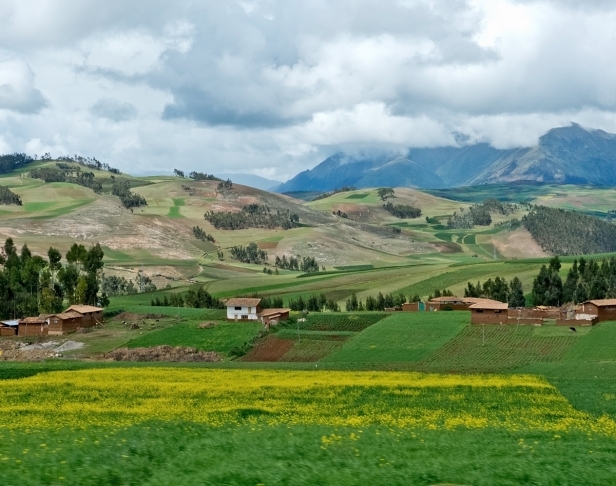
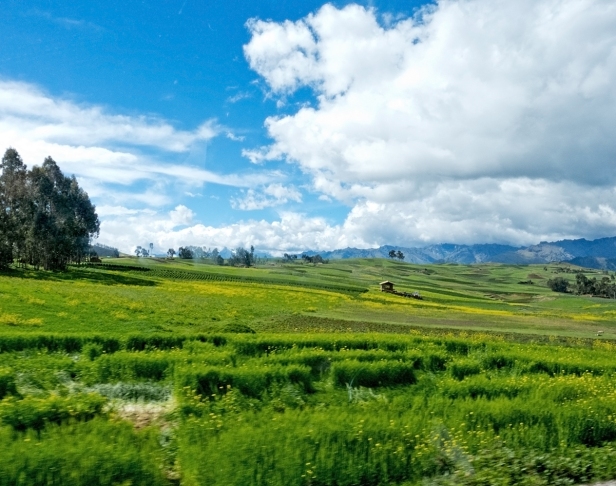

The town was one of the royal estates of Pachacuti Inca, who conquered the area. In the mid 1400’s he ordered the building of extensive agricultural terracing and irrigation systems in the Urubamba valley. He had the town built as housing for the nobility, and next to the town, high on a hill above the terracing, a temple. The terraces and irrigation systems allowed farming on otherwise unusable land. One of the most remarkable things about the Inca was their ability to convert steep rugged mountainsides into viable agricultural land with the creation of “climate-control” terracing, and elaborate irrigation systems. They became rich through hard work and astonishing ingenuity.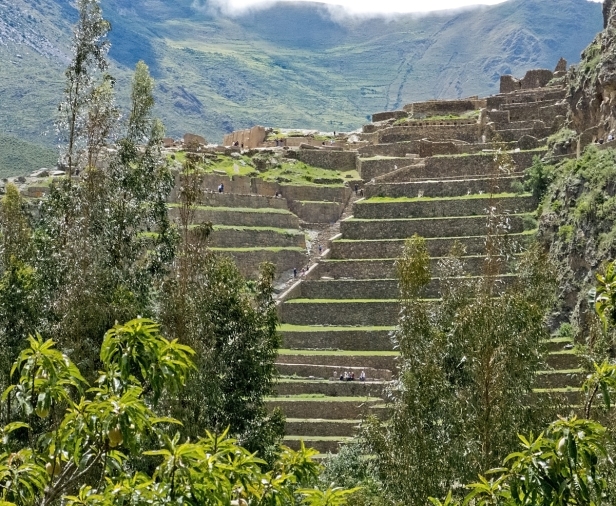

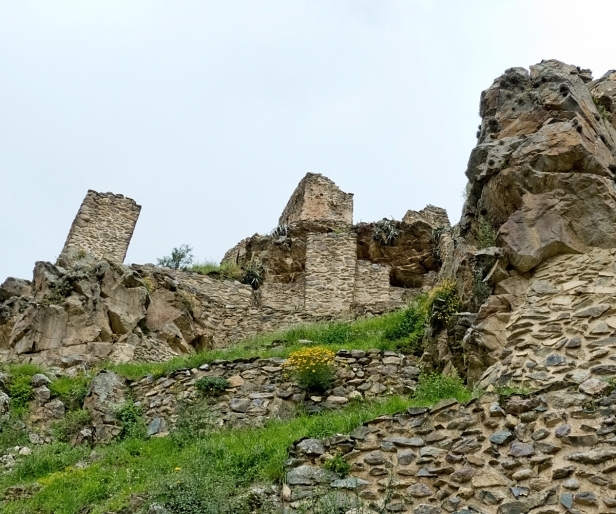
According to legend Ollanta was a fearless captain in the Inca army. So fearless he fell in love with the Emperor’s daughter and asked for her hand in marriage. He was refused permission to marry her because the Inca did not allow marriage between different social classes. So the angry Ollanta rebelled and ran away from Cusco to the royal estate that eventually became known as Ollantaytambo. He holed up there and fought with the Emperor. One has to assume he had some kind of rebel force fighting with him. After ten troubled years of conflict he was captured, and then pardoned by the son of the now deceased Emperor, who also allowed him to marry his sister. I like to think that Ollanta’s persistence and courage (or foolishness, depending on your point of view) led to more liberal marriage customs. And clearly the new Emperor was a good guy. Or had something to gain from the marriage.
Ollanta is a living Inca city. It has some of the oldest continually inhabited buildings in the world. Built over 600 years ago, to walk the streets or to enter one of the courtyards of these dwellings is like travelling back in time.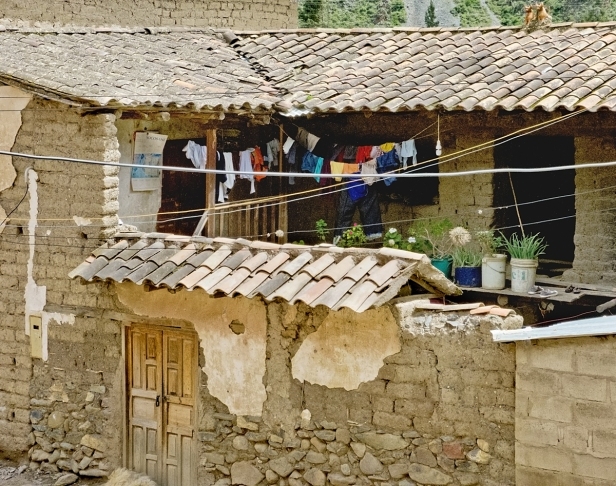
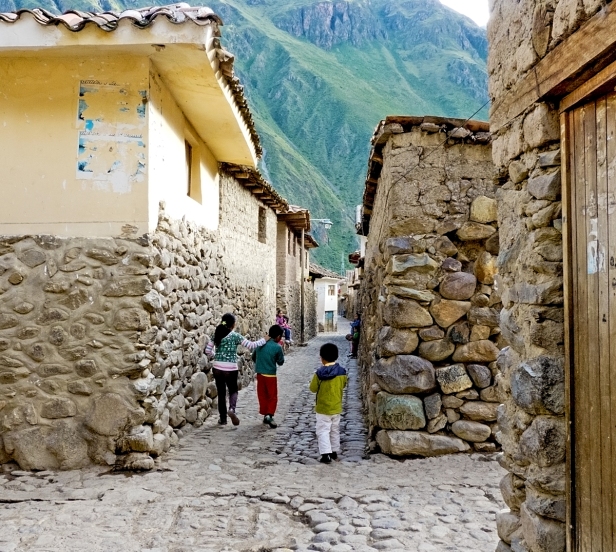

It seems just about every time I read online about any one of the Inca ruins it says it was built about the mid 1400’s, the time of the reign of Pachacuti. He is also responsible for Machu Picchu. He must have been one busy guy. I’m not an archaeologist, it’s not my purpose to write a history blog, and I know Wiki is not the most reliable source of information, but I do get the feeling that the 1400’s were the time of greatest power and expansion of the Inca Empire.
Today the homes of Ollantaytambo are largely inhabited by the distant descendants of the original residents. Many still dress in the traditional way with sumptuous detailed woven fabrics, and elaborate hats and hatbands, and the same love of bright colours seen throughout the Peruvian Andes. I love the exuberance of their clothing, and their fearless embrace of colour. Many are wearing ordinary (and I do mean ordinary) western dress these days but it was not hard to find entire families still favouring traditional dress. The following photos were all taken in the town on regular days, people going about their business as usual.
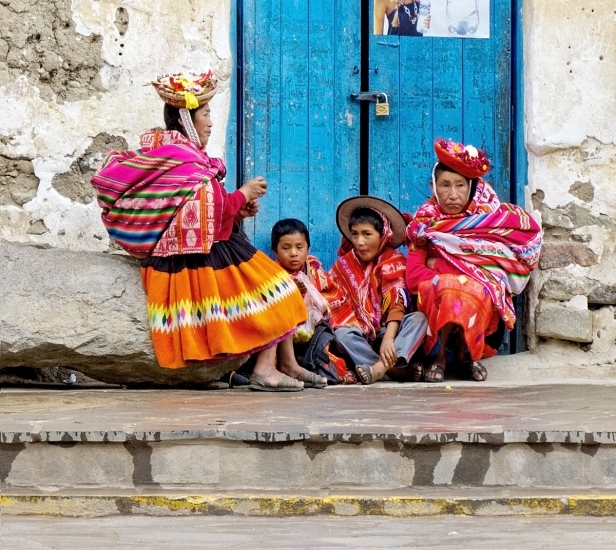
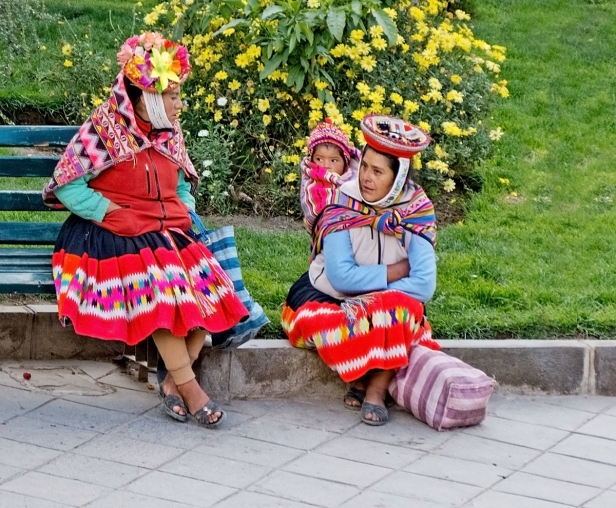

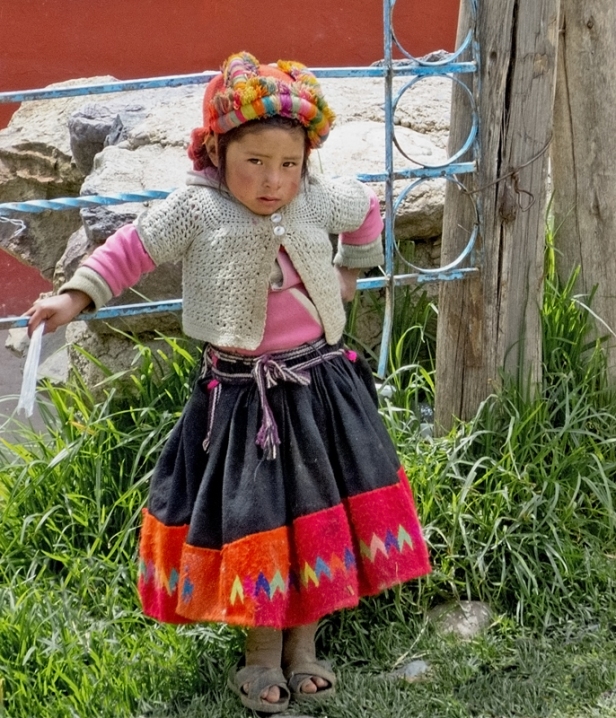
And then there was this wonderful woman who stopped to talk with us as we sat at an outside café. What a personality! We were told she is 92, and obviously still going strong.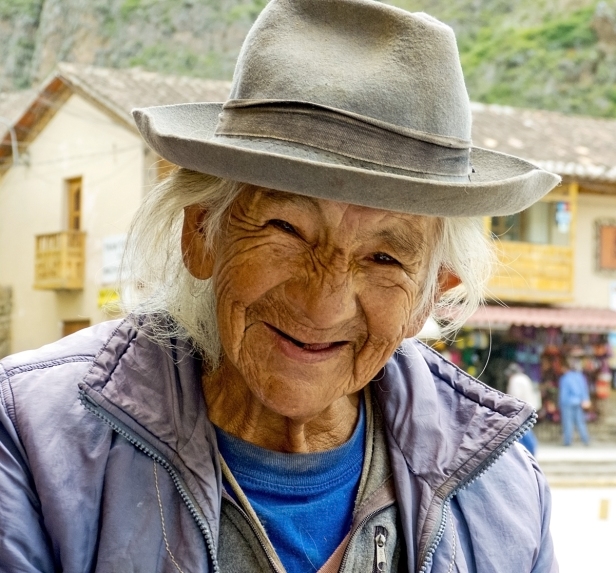
We first went to Ollantaytambo for Fiesta de los Reyes, also known as Bajada de los Reyes, meaning Descent of the Kings, celebrating the arrival of the three kings to welcome the baby Jesus. It is celebrated throughout the Sacred Valley, but most flamboyantly in Ollantaytambo. Known as Epiphany in the church, in typical Andean style it is much more than a Catholic religious service. I wish I understood more about the fantastical characters that come out to play on festival days. The festivals are all nominally Catholic, and follow the celebration and worship calendar of the Catholic Church. Often the reason for a festival is based on this calendar (in this case the recognition of Epiphany) or on the celebration of a saint’s day, but there is always much much more going on than the Catholic agenda. Always there is the celebration and worship and dancing to and for the traditional gods, and although Christian effigies are carried on biers through the streets, it really seems to be as much, or more, about the old gods, the old ways of honouring and celebrating and paying homage to them. Maybe one day I’ll go to the Andes and study festival dances and costumes and find out the significance of them. Meanwhile all I have are these photos of an enthusiastic dance through the streets of some fabulously wild and imaginative characters.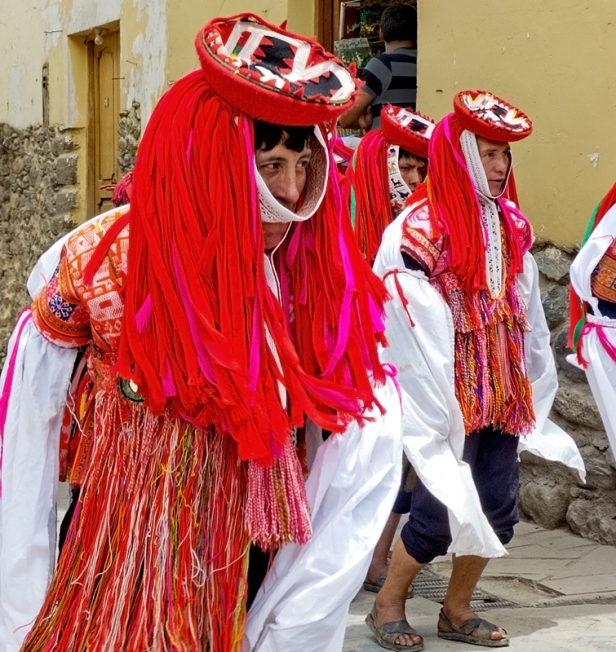


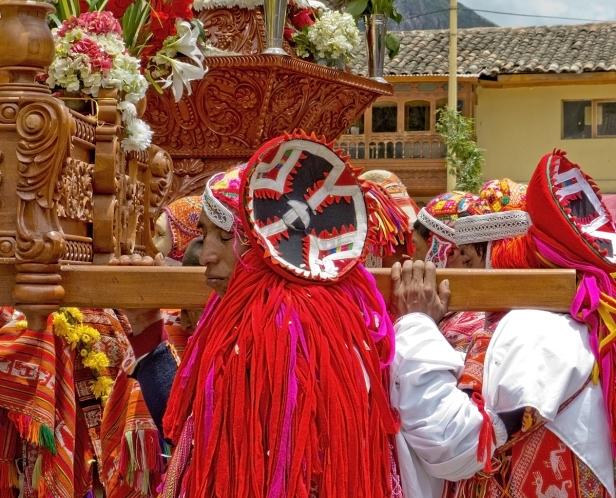
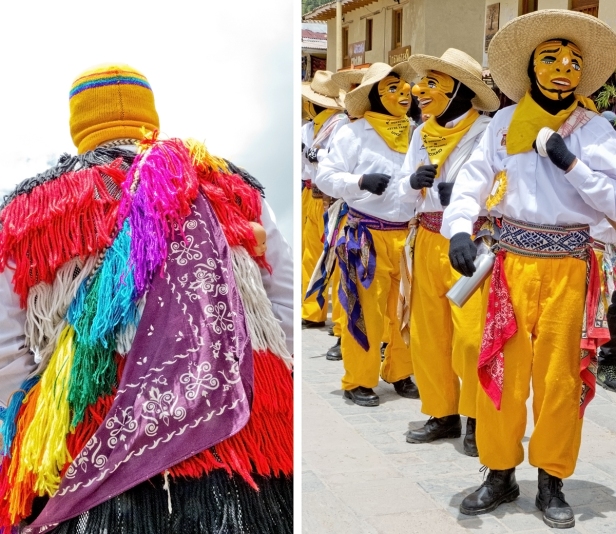
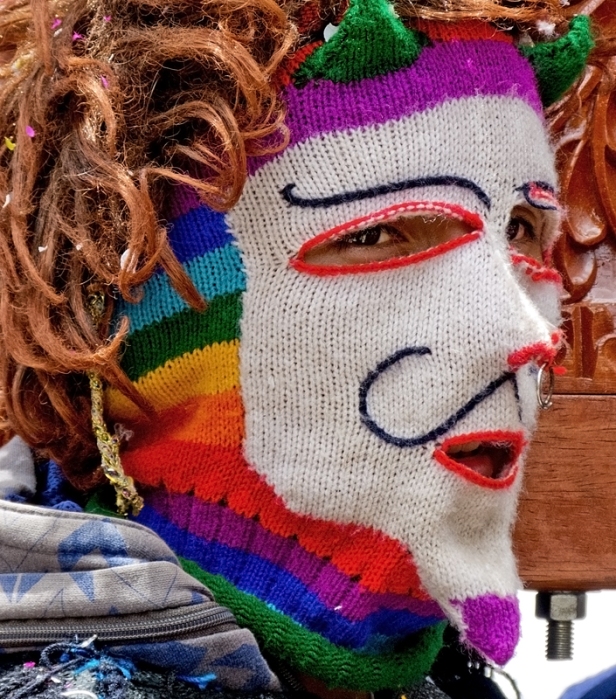
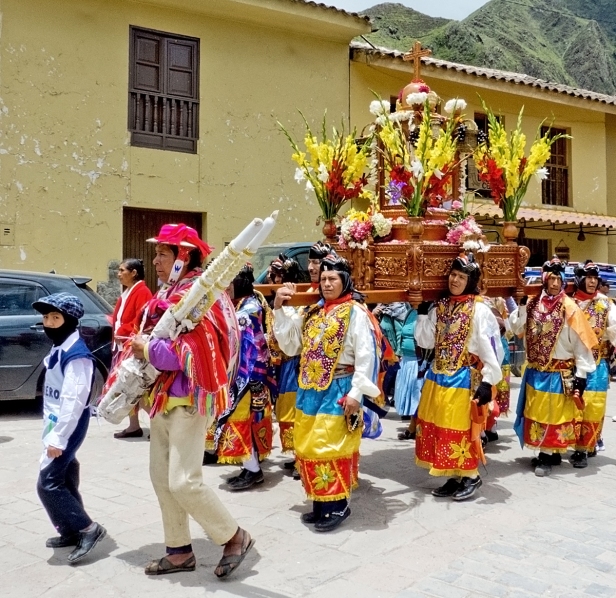


Dressed in traditional clothing, residents from surrounding communities walk into town for the festival. And all the people of Ollantaytambo put on their finest outfits to honour the occasion. The ‘audience’ is as colourful as the parade.

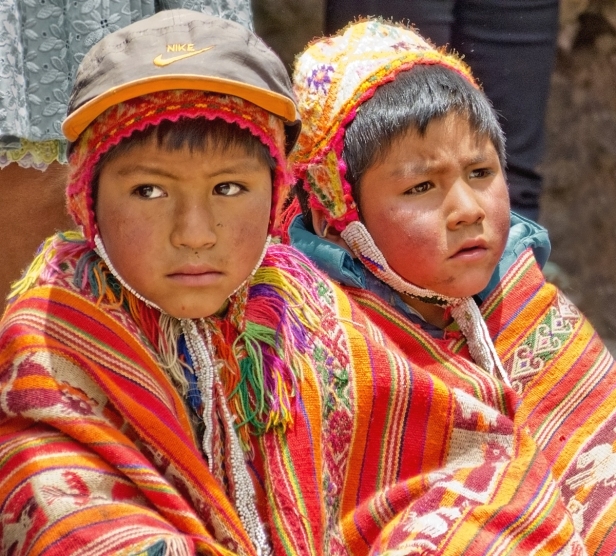
And then we discovered there was to be a bullfight!
On the edge of town – a bullring
We’d never been to a bullfight, nor ever thought we would, but here was an experience being handed to us so we said yes. To a point. We were there early and so we found ourselves a good position standing on a wall, back a bit from the main seating, and watched as the stadium, and then the hill behind us, filled up. By the time the action started the crowd numbered well into the hundreds.
A small part of the crowd on the hill: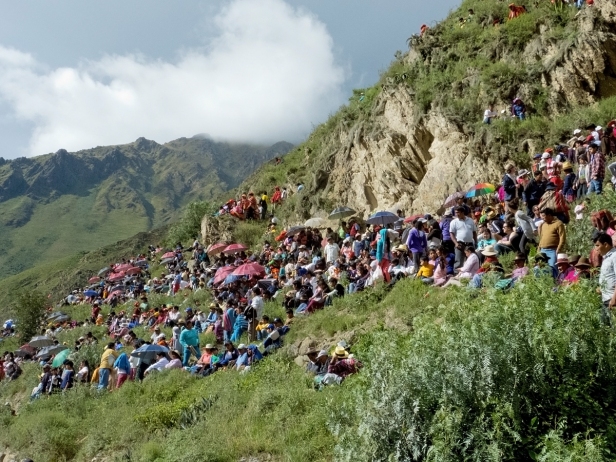
There were five toreadors in all and they were acclaimed with great fanfare. A small young bull was released into the arena and used as a warm-up as they took turns taunting it into action with their bright neon capes. This part was actually quite entertaining to watch. The young bull was perhaps confused, and perhaps somewhat frightened, but no real harm was being done to it. They waved their capes, the bull responded instinctively, and the toreadors danced and pirouetted around it.
The young bull was wrestled out of the arena by a couple of wranglers and replaced by an older, bigger bull. The real thing. This was no longer just a warm-up. For quite some time the toreadors again took turns taunting it with their capes. And then it suddenly happened. One of them walked out from behind one of the red protective barriers carrying two lances. He walked carefully up to the bull and jabbed them deliberately and with force and precision into the back of its neck, and then danced away. The bull reacted in pain and terror. I was horrified. I don’t live under a rock. I know this happens in bullfights, but to see it live is really awful. And naively, up until this happened, I thought that maybe it was just going to be all about the action with the capes. Apart from the fact that it was now time to catch our bus back to Cusco, both Don and I agreed that it was enough. It was time to leave. Neither of us could stomach seeing any more.
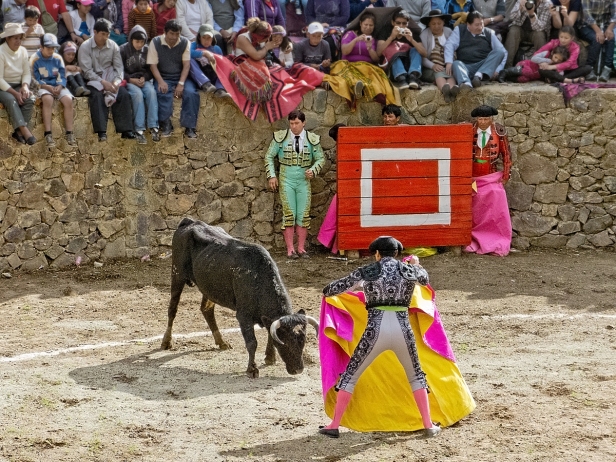
My understanding is that the bull is taunted with more and more lances jabbed into its back by the appropriately named picadors, and by the matadors and toreadors and all the other ‘dors’ waving their capes at it to heighten it’s fear and frustration until finally it is so exhausted that one of the brave ‘dors’ hops in there and kills it. It is then dragged out of the stadium. I know this very end part only because I caught a glimpse of it on TV in some South American restaurant. To me the whole thing smacks more of cruelty and torture than heroism, and yet there is obviously some aspect of humanity that loves it, craves it. We saw the very large audience going wild with every ‘success’ the toreadors had over the bull.
On that cheerful note I will end this post, leaving you all to think (or not) about the human condition. And bullfight or not, Ollantaytambo is a delightful town.
Next post: After the Andes and the Sacred Valley, time for the big city: Lima, Peru’s capital.
All words and images by Alison Louise Armstrong unless otherwise noted
© Alison Louise Armstrong and Adventures in Wonderland – a pilgrimage of the heart, 2010-2015.

I really like this colorful and different culture.
LikeLike
Thanks Ajay. We found it very interesting, and an exciting place to visit because it is so different from our western life.
We loved the colours of India too!
LikeLike
Oh so much to love about this post, Alison! Interesting and well written, superb photography, and beautiful colors and people! Among my favorite photos: the elderly lady who sat and spoke with you – simply lovely! The little boy with the Nike cap over his traditional hat! The four people sitting on a bench – three in traditional dress and the gentleman in western clothing – begs the question if you have the option to wear such beautiful traditional clothing, why would anyone choose western attire? All the parade shots. The little girl at the bottom of the photo with several ladies. I could go on! But then I’d just list every single photo! Have you written about your photography? I haven’t yet read all of your past blogs, so if you’ve told how you get such magnificent photos, I haven’t seen it. My photography skills are sadly lacking, and I’d love to improve them!
I’m with you about the bullfight. It’s hard to imagine being entertained by cruelty. As always, thanks for a most interesting blog!
LikeLike
Thank you so much Kaye. I’m so glad you enjoy the post, and the photos! I get drawn in with such gorgeous subject matter. I haven’t written a post about photography, but maybe it’s time I did. I regard myself as an amateur. I’ve learned a lot technically from two sisters who are, or have been, professional photographers, but what I know is pretty basic. I learned about colour/composition/design from years of art classes in school and the an extra year in art school. My equipment is far from professional but I’m planning an upgrade soon. I love photoshop!
Alison
LikeLike
An very interesting read and fabulous photography to accompany it – thank you!
LikeLike
Thank you so much. I’m glad you enjoyed it. Thanks for visiting.
LikeLike
How incredible those old stone houses are and the whole town!
LikeLike
Thanks. Isn’t it an amazing place?! We loved it. So old and weathered and full of character – just like the woman I photographed.
LikeLike
Simply stunning! One can tell from the photos how embedded you are in the place. You are not just an observer, you are a part of the place. Remarkable!
LikeLike
Wow Cindy. Thank you so much. That’s a huge compliment. I am honoured. I must say that this is what I seek. I love the exotic – at least that which is exotic for me, knowing that for the people I photograph it’s just ordinary life. There’s something about both the historical aspects of a place, and the exotic, that draws me in in a way that is joyously thrilling. At the time it is happening I can’t get enough if it. There’s a constant reaching to understand it, to experience it, to embrace it.
LikeLike
I wonder if the people of Ollanta truly realize how cool it is to live in homes that were first built over 600 years ago. And I love the characters who came out for the festival, especially the ones in the brilliant yellow outfits!
LikeLike
Thanks Felicity. Maybe they just take for granted the way they live, though they surely must know that the tourists find their lifestyle interesting.
We loved the festival too, but it was small compared to the Candelaria Festival in Puno – much about this to come in future posts. It went on for 2 weeks and was extraordinary.
LikeLike
The bullfight – how horrible! Just horrible. At least you wrote about it beautifully. So glad I wasn’t there for that, and I’m sorry for the pain it caused you and Don.
As always, your close-up pictures of people make me stare in wonder.
And I loved these fabulous sentences: “Many still dress in the traditional way with sumptuous detailed woven fabrics, and elaborate hats and hatbands, and the same love of bright colours seen throughout the Peruvian Andes. I love the exuberance of their clothing, and their fearless embrace of colour.” I agree completely with your second sentence.
Blessings to you and Don, Alison!
LikeLike
The bullfight was okay in the beginning – watching the skill of the toreadors was quite exciting and the bulls, although being used, were not being harmed. With the lances it became horrible so we left right away, and I don’t want to think about what happened after. We didn’t have nightmares or anything, but perhaps I might have if we’d stayed til the end.
I’m glad you enjoyed the rest of the post 🙂
Blessings from us, Alison
xox
LikeLike
Gorgeous post. So vibrant and alive. It feels like you’re jumping off the page. There’s such an alive energy with this.
LikeLike
Thanks Paulette, I’m glad you can feel it. It always takes me a while to get a post going. I start with choosing photos, and always have way too many, and then I whittle them down and the whole while I’m thinking what on earth am I going to write, I have no idea what to say about this place. Then I start writing, slowly, as if through molasses. Eventually it gains its own momentum and starts to flow. So thank you! It’s good to hear that the sense I had of being there comes through.
xoxox
LikeLike
The color everywhere is amazing, as are all of your photographs. It is always such a pleasure to read your posts and see such beautiful photos.
LikeLike
Thanks so much Angeline. We loved all the colour in the traditional clothes, and in the festival costumes in South America. So rich and beautiful.
LikeLike
Hi Ali, I leave for Lima on Monday. I read that you will post next on Lima. Did you find it worthwhile to spend some days there?
LikeLike
We had a week in Lima and didn’t do much. There’s an amazing fountain/light/music show most evenings I think that is really worth seeing. We’re in transit (in London – go to Cypress tomorrow). I’ll try to find some details tomorrow.
xox
LikeLike
Thanks, Ali. I hope your travels go well and that you really enjoy Cyprus. I’lll go there some day. I have loved my Mediterranean travels so far. Love, Ruth (with a ‘t’)
LikeLike
I figured it out.
Seeing your email address was a big clue 🙂
Have a fabulous time in Peru!
LikeLike
Parque de la Reserva has the Curcuito Mágico del Agua. Many fountains to wander around/through, quite lovely. Show starts 7.15pm at the Fantasy Fountain and is quite spectacular and worth seeing. Apart from that we’d say Lima is not a place to spend a lot of time esp if your time in Peru is limited. Hope this helps. Ali xoxox
Oh and there’s a cathedral/monastery downtown with hundreds of years of human bones in the catacombs that’s quite interesting if that kind of stuff appeals to you – Monastery of Saint Francis.
LikeLike
I too am sickened by bull fights, Alison. I saw once on Spain many years ago and said never again. When I’ve seen bits on TV where the bull gores the matador, I cheer inwardly.
LikeLike
Yes, even the little bit we saw was pretty appalling. We had to leave. I don’t understand the appeal at all. Can’t imagine seeing the bull goring a matador. Ugh, but no doubt deserved.
LikeLike
Loved the old woman. 92 years of beautiful character.
As for the bullfight, you two have more fortitude than I. There is no way I would watch one. But you did a great job of capturing the horror of the experience. –Curt
LikeLike
Isn’t she a beauty?! I’ve several very animated photos of her – will probably publish some of them one day.
The bullfight, awful! We were so naive. We thought it would be just the capes, and immediately left when it was worse than that. Never again.
LikeLike
The older woman would definitely be worth her own photo essay and I suspect would go well with a magazine article.
If I even get near bull fighting arenas I get queasy. –Curt
LikeLike
I have read your blog with great interest and wanted to know if it would be possible to use one of your photos for a painting? I am a professional painter and my work can be found at http://www.galleriadante.com. Thank you in advance and keep traveling!
LikeLike
Hi Cherie, your paintings are beautiful! I’d be happy for you to use one of my photographs. Which one did you have in mind? Would you give credit for it such as ‘from the photograph by Alison Armstrong’? I don’t know what the usual etiquette is in these cases. I have a friend who lives in La Manzanilla (a few hours south of Puerto Vallarta) who paints from photographs and I’m not sure if she does that or not. Anyway thank you for this lovely compliment. Cheers, Alison
LikeLike
Alison and Don,
Love your blog. You both educate and inspire me.
I saw my first bullfight (in Tulum, Mexico) after stumbling upon a crowd outside a pen at a street festival.I wrote about it on my blog eachtinymoment.com.
It was very amateurish compared to the one you saw. Let’s just say, the bull prevailed.
Your writing and photos are the next best thing to being there.
Keep up the great work!
LikeLike
Thank you so much Paul for your lovely compliments. It means a lot that you get a bit of the feeling of being there.
And I’m glad to hear that sometimes the bull prevails 🙂
LikeLike
Beautiful pictures!. Thanks for share all these experience with us.
Belu | TTP
LikeLike
Thank you so much Belu. It’s my pleasure to share it. I’m glad you enjoyed it,
Alison
LikeLike
Unbelievable photos! How fortunate you are to have seen these people and scenes with your own eyes. And fortunate for your followers that you are sharing these magical images and stories. Thank you Ali and Don!
LikeLike
Thank you Helga. Yes we are fortunate indeed – such colour and richness, and yet to these people it is ordinary everyday life. That’s part of what I find so fascinating about travelling – that what is exotic to us is ordinary to others. I’m glad your enjoying our travels through exotic South America.
Alison
LikeLike
Again you show us staggeringly beautiful photographs !
Good on you both for your adventurous spirit and wonderful eye..
LikeLike
Thank you so much Marina. I’m glad you enjoyed the photographs. I love all the wonderful fantastical costumes, and traditional dress – so colourful and vibrant, and the countryside so beautiful. It was such a rich time for us, it’s wonderful to be able to share it.
LikeLike
How interesting that we are going to be in the area almost at the same that dates that you were several years ago! Just a tad bit later, we expect to arrive in Cusco after Ollantaytambo, probably in the middle of Carnaval. 🙂 I haven’t seen a live-kill bull fight yet, and I am glad that I have this information about the Peruvian Andes. We saw numerous bull fights in Ecuador but the laws are different, and none of them resulted into harm to the bulls. Maybe we will shy away from this more brutal version.
LikeLiked by 1 person
I imagine Cusco at Carnaval will be amazing! Also try to get to Chinchero on the first Sunday of the month – amazing religious festival that day. There’s a post about it.
Just couldn’t stomach the cruelty of the bull fight. Inside I was screaming along with the bull.
Alison
LikeLike